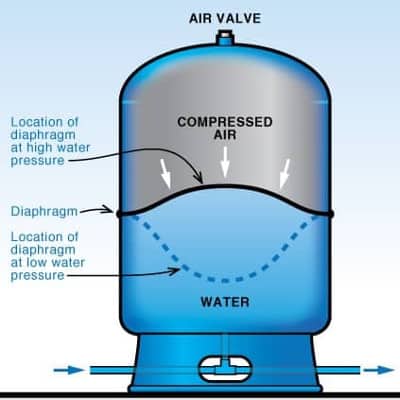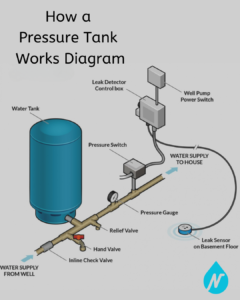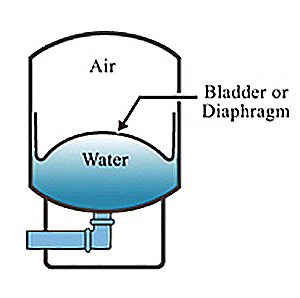Pressure Tank: The Basics

Well Water Pressure Tank…
Simple, functional, and extremely important in the cycle of your home or office water.

There are an estimated 4 million water wells in the United States. That means there are well drilling companies, like ours, that have helped create access to the groundwater those millions of families and businesses depend on. We also then keep the ‘pressure on’, so to speak, as we continuously move the water from an underground aquifer, pumping it through the plumbing that carries it into the home or office for usage, ensuring it’s flowing smoothly at all times.
It’s by applying a continual flow utilizing a constant pressure pump that keeps this life essential gift of nature available for drinking, bathing, washing clothes, dishes and so much more.
However, we can’t allow the well itself and the constant pressure pump to take all the glory in making this happen. There’s also another piece to the puzzle that we’d like to tell you about. The water pressure tank.
On its surface, a water pressure tank doesn’t look like much. Basically, it’s a holding tank for your well water and…it kind of looks like a blue minion.
Okay, maybe it’s not that exciting, but its functions do play a pretty important role as a water storage tank and is ‘well’ (total pun intended) worth the time when you’re trying to understand how well pumps and pressure tanks work.
How Does a Pressure Tank Work?

Here are the basics that show the water supply (once it’s pumped from the submersible pump underground outside) entering the home from the well traveling through to the check and hand valves as it flows into the pressure tank. Water will then be stored there until it’s summoned from a faucet or other site for usage. The pressure switch then signals the pump to kick on and run.
To help buffer overwhelming the pump, the pressure tank has a set amount (depending on its size) of water in its reserve to help alleviate the pump having to run continuously. It also holds a certain amount of compressed air that maintains a range of pressure in the tank that forces water out into the line when a spigot or other source is opened.
When pressure drops below the preset level it engages the controls necessary, like the well pressure switch, telling the pump to turn on to begin pumping water into the tank. A valve at the top of the tank that can be used to inject the proper amount of air needed to keep tank settings running efficiently.
High Pressure Tanks:
How a Bladder Tank Works Vs. How a Diaphragm Pressure Tank Works and the Traditional Air Over Style Tank that is still in use today.

Aren’t all pressure tanks the same? Well, no. This diagram shows a bit more detail when it comes to bladder vs diaphragm pressure tanks vs air over water pressure tanks.
Aside from shape and size differences, pressure tanks for well pumps look the same on the surface. Their outer shell is a durable protective shield and maintains the pressure inside. It offers an air valve, or schrader valve, for easy access during service without moving or replacing the tank settled on a durable steel base for support.
Once we peer inside, we see many other facets that keep what we feel is the best pressure tank brand or best water pressure tank on the market, WellXTrol, the brand we use, functioning at full capacity. You may still find the traditional style pressure tanks in use today but most newer well systems now fluctuate between the bladder vs diaphragm pressure tanks. You can learn more about the different styles here.
Common Problems That Can Occur with Your Pressure Tank System
Bad pressure tank symptoms can take place depending on any number of factors, depending on the style you have. Some key symptoms to keep an eye on:
- High fluctuation of water pressure throughout your home or office space
- Abnormal clicking sounds coming from the tank
- Extremely hot water in the shower
- Air spurts from your faucets (a rupture can occur in either diaphragm or bladder pressure tanks causing air to mix in the line).
- A spike in your energy bill
- Loss of water pressure

One additional situation that can sometimes be an unforeseen problem, no matter what style of tank, whether air over water, diaphragm or bladder tank is when pressure is too high. When there is an expansion of tank pressure from air, it reduces the amount of water that can be stored.
Until 1970, private water systems used the galvanized well tank, or air over water tank mentioned earlier, which was more prevalent to this issue because unlike a bladder or diaphragm tank that separates the water and air, this system allowed them to mix causing the air to be absorbed into the water, needing to be replaced to keep it from becoming ‘waterlogged’.
Some additional inquiries you may have could be:
- How do I know what to choose when looking into diaphragm or bladder tank sizes?
- How much does a pressure tank cost?
- How to charge a pressure tank?
- How to drain a water pressure tank?
- How to add air back to a water pressure tank?
- How do I know ‘if’ and how to fix a waterlogged bladder pressure tank?
We hope you find this information helpful. If you’re somewhat savvy with installation and repair work when it comes to how to set a pressure tank, how to plumb a pressure tank, how to increase pressure in your water tank and everything in between, we think that’s great as it will save you money!
However, if you ever find yourself needing our services, our Negley’s Water team is always here for you. Find more about our office locations, or to schedule a free consultation we encourage you to call us, 888-458-2118 or click for a FREE QUOTE.